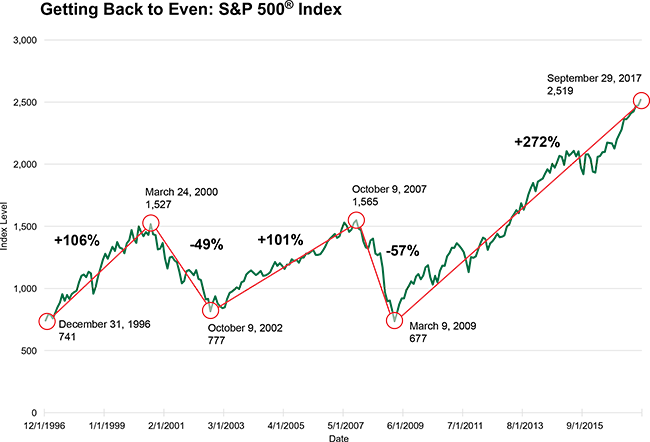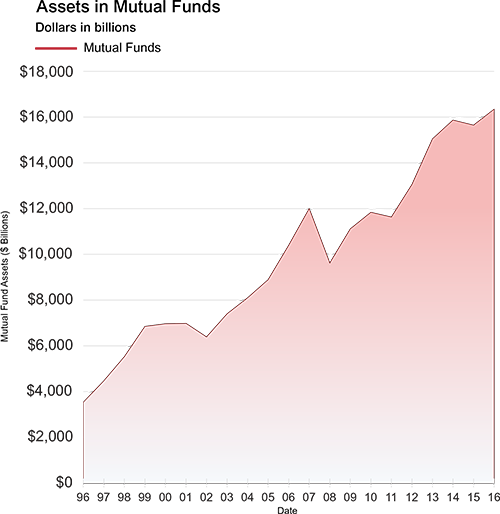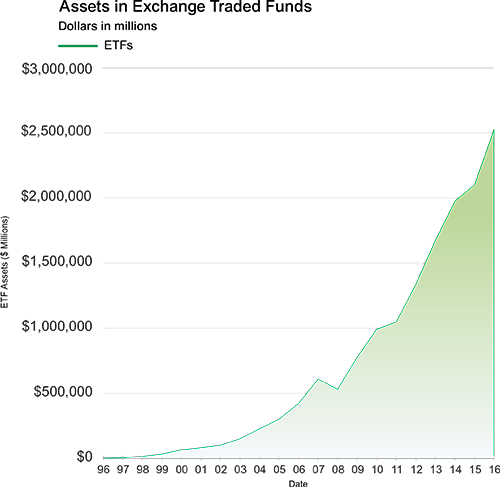The Evolution of an Industry
The financial services industry is going through one of the greatest transformations in its history. This includes everything from the needs and attitudes of investors to the way advisors run their business.
A Changing Investor
In today’s uncertain and volatile economy, investors are still recovering financially and emotionally. Most people are familiar with the technology bubble in the early 2000s and the recession from 2007-2009, but there has also been 25 bear marketsadditional corrections, or temporary price declines, in the market (as of December 6, 2017) since the Great Depression of 1929.. As a result, investors are looking at their financial goals differently.
Today clients share four investment concerns:
- Growth
- Protection
- Taxes
- Cost

| Did You Know? |
| -49.00% The amount investors lost after the dot com bubble burst (between March 24, 2000 and October 9, 2002) |
| +101.00% Investors gained this amount between October 9, 2002 and October 9, 2007 |
| -57.00% During the housing crisis from October 9, 2007 and March 9, 2009, the market dropped a staggering 57.00% |
| +272.00% Since March 9, 2009, the market has rebounded 272% |
Past performance is not indicative of future results.
The Age of the Baby Boomers
10,000 people celebrate their 65th birthdays every day for the next 19 years in the United States since January 1, 20111.
77 million: current estimate on how many baby boomers are in the United States today, making up 25% of the U.S. population2.
As these baby boomers head into retirement, they will look for ways to enhance their wealth and use it as a tool for themselves as well as their future generations.
They will transfer trillions of dollars over the next thirty years and will demand smart, sophisticated financial strategies including wealth management, philanthropy, and tax management solutions.
These strategies need to address:
- Wealth accumulation
- Longer life expectancy
- Volatility of the market
- Inflation & higher cost of living
- Income planning for larger life expectancy
¹Annuity Digest, Jan 7, 2011
²www.prb.org, April 2014
The Market


In the past 15 years more investors have entered the financial marketplace than ever before. For years mutual funds have remained the most popular investment option for investors with over $15 trillion in total net assets as of December, 2015.
But as investors look for more diverse, low cost, tax efficient options, exchange traded products have gained an incredible following in a short period of time.
Assets by product
- Mutual Funds – $16.3 trillion in total net assets as of December 2016.
- All ETFs - $2.229 trillion net assets in ETFs as of December 2016.
We believe this market trend will continue to grow and investors will use more exchange traded products for their retirement needs.
Pacer Financial aims to offer the products and strategies that are at the forefront of the financial industry.
*Investment Company Institute, January, 2017.
An investor should consider the investment objectives, risks, charges and expenses of an investment company before investing. Please read the prospectus or summary prospectus, if available, carefully before investing.
Monetary Trends
Weekly Money Market Fund Assets
The weekly total money market fund assets increased by $2.73 trillion to $2.74 trillion for the week ended Wednesday, November 8, 2017.
Weekly Estimated Long-Term Mutual Fund Flows
Total estimated inflows to long-term mutual funds and exchange-traded funds (ETFs) were $7.76 billion for the week ended November 8, 2017
Monthly Trends in Mutual Fund Investing
The combined assets of the nation’s mutual funds increased by $270.6 billion, or 1.5 percent, to $18.1 trillion in September 2017.
Monthly Exchange-Traded Fund Assets
The combined assets of the nation’s exchange-traded funds (ETFs) were $3.137 trillion in September 2017.
Monthly Unit Investment Trusts Data
Unit investment trusts, investment companies that hold fixed portfolios of selected stocks or bonds, had total deposits of $4.56 billion in October 2017.
Quarterly Closed-End Fund Assets
The combined assets of the nation’s closed-end funds were $270.61 billion at the end of June 2017.
Quarterly Worldwide Open-End Fund Assets
Worldwide regulated open-end fund assets increased 4.7 percent to $44.78 trillion at the end of the second quarter of 2017, excluding funds of funds.
The U.S. Retirement Market Quarterly Data
Total US retirement assets were $26.6 trillion as of June 30, 2017, up 1.9 percent from March 31, 2017. Retirement assets accounted for 34 percent of all household financial assets in the United States at the end of June 2017.
Investment Company Institute http://www.ici.org/

